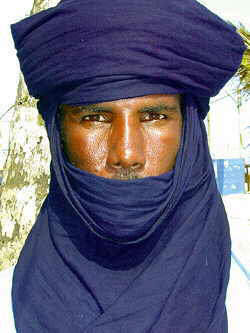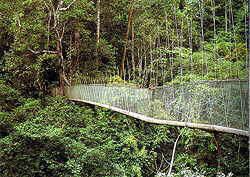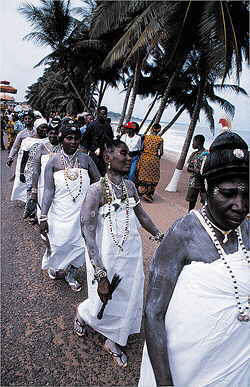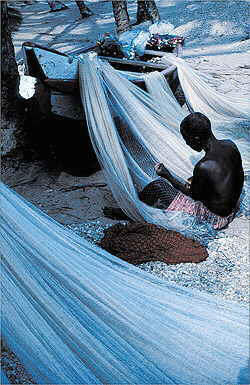 GHANA´S MAIN KINGDOMS GHANA´S MAIN KINGDOMS |
 Northern Zone Northern Zone |
The Mamprusi, the Mossi, Dagomba and Gonja are ethnic groups in the Northern Upper Regions that come under the collective population of Mole-Dagbani.
All except the Gonja trace their origin to one common ancestor. The founders of the Mole-Dagbani states succeeded in organizing centralised administrative systems in the fifteenth and sixteenth centuries.
The supreme ruler over the Mamprusi was the "Nayiri". The Ya Na exercised supreme authority over the Dagombas. The Yagbumwura was the paramount ruler of the Gonja State. The responsibilities of the rulers were to give laws, to declare wars to make peace and to administer justice.

The State Council assisted the rulers in administrating the land. Officials like the “tarana”, the “wuadana”, the “kpanarana” and the “nazo” on the State Council assisted the Nayiri. The Nayiri might consult the divisional chiefs on matters of grave importance. A very well laid out political system created a healthy and stable political atmosphere for development. Peace at home was extended to their neighbours. The states were in close military alliance with one another. Agriculture flourished among the population of Mole-Dagbani also because of the existence of peace and order. Taxes were paid on produce resulting in revenue that was used by the rulers for the administration f land and to build industries such as the weaving and leather works. These flourished, leading to a healthy trade with the Western Sudan in the north. There was also trade with the Hausa states and Mali. Commercial centres were established at Wa, Bole and Begho. Trade routes linked the gold, ivory and kola nut trades in Akan land. Learned scholars helped to foster Islamic education among the people. Consequently, Moslem scholars in Ghana began producing literary works that further enhanced the development of the states. The economic potentials of the region generated trade, attracted various craftsmen and also brought cultural and political ideas to be used by the rulers and the people.
 Forest Zone Forest Zone |

The Akan states in the forest emerged between 1300 and 1700 A.D. The development of iron technology made possible man's penetration and subsequent settlement into the forest zone. Agriculture, among other works, was made easier.
Large states such as Akyen, Akwamu, Ashanti and Denkyira were able to develop into political states by the end of the seventeenth century, after the development of iron technology. The economic endowments of the zone and the political ambitions of certain families to control and exploit these resources also contributed to the development of the states in the forest zone. There was an abundance of gold, ivory, kola nuts and other forest products.
Skilful leadership was also a great asset to the states of the forest zone in their emergence and rise into great states. These leaders were gifted with the art of statecraft to organize their families and clans into formidable states and kingdoms.
 The Fanti State The Fanti State |

The Fanti state occupies the coastal belt of Ghana, from Pra in the West to about twenty-four kilometres west of Accra, the current capital of Ghana. The Fanti states included the Eguafo, Dena (Elmina), the Efutu, Asebu, the Etsii, Komenda and shama. The Fanti controlled well-established kingdoms on the coast by the beginning of the fifteenth century.
The Fanti first settled at Mankesim, on the coast. The first Fanti states to settle along the coast were Mankesim, abora, Anyan, Ekunfi and Nkusukum. Gomoa and Adjumako joined them later. Civil war characterised the political life of the Fanti at Mankesim in the middle of the seventeenth century. The conflicts wee over who should rule who. All groups claimed to be equal. The misunderstandings and wars compelled groups of the Ganti at Mankesin to move away from the troubles to establish peaceful settlements elsewhere. Groups also moved because of the desire to benefit from trade with European merchants. Competition to control the trade routes to the inland areas among the Fanti states themselves also made them move to the coast. | The rising power of Ashanti generated the fear that Ashanti would move southwards to occupy Fantiland and the coast in general. With the defeat of Denkyira by Ashanti, traders from Ashanti were seen coming down the coast to trade with the Europeans.
The role of middlemen played by the Fanti therefore became threatened. In order to maintain their position as middlemen the Fanti absorbed the neighbouring states. The Fanti dominated the coastal trade in firearms and the trade routes to the interior. To face the danger coming from the Ashanti, the Fanti considered it necessary to untie as one people. Abora became their headquarters instead of Mankesim. The Fanti had a Council of paramount chiefs or "Amanhin" as the supreme governing body of Fantiland. Periodically, chiefs of the various areas met to deliberate and find solutions to matters affecting the people.
 The Ga-Adangbe Kingdoms The Ga-Adangbe Kingdoms |
There is no data about the date of emergence of the Ga into a kingdom. Originally they lived in scattered communities, but at the beginning of the 17th century they were able to create the powerful kingdom of Accra. Ayawaso became the capital of the Ga Kingdom.
Little Accra, Osu, La and Tema were established as settlements around the capital.
The Ga and the Adangbe did not initially have chiefs. Family heads of the settlements, which were grouped into quarters called akutesei, looked after the welfare of the people. The family heads ensured peace and harmony amongst their members and their neighbours. Political and social authorities resided in the traditional priests, the most important of whom was the Wulomo. The Ga later adopted some Akan political, social and military institutions.
Oral tradition teaches us that Great Accra was founded by Ayite, son of Ayi Kushi, the first king who was believed to have led them to their present settlement. The Kingdom however reached the peak of power under King Okai Kwei. The Ga dominated coastal trade with the interior people. They established a market at Abonse, a few miles north-east of Great Accra. By so doing, the Ga succeeded in confining the Akyem, the Akwamu and Kwahu traders at this market to trade only with them, and prevented them from coming into direct trading contact with the Europeans on the coast.
The Akwamu, wishing to have direct trade with the Europeans, engaged Accra in a battle in 1677. The battle of Nyantrabi in 1677 was the result of a decisive defeat of the Ga by the Akwamu under their King Ansa Sasraku. Okai Kwei was killed and the capital captured. Accra became a vassal to Akwamu until 1739.
 The Ewe States The Ewe States |

There were about 120 states in Eweland at the beginning of the seventeenth century. The Anlo state alone consisted of 36 towns and villages. The Ewe states today include the Anlo, some, Dzodze, Adaklu, Ave, Abutia, Peki, Ho, Waya, Kpando, Taviefe and 13 Tongu states. The Ewe states devised important structures that contributed to their rise and growth. Political organisation was well structured and responsibilities of office-holders well defined.
The highest political unit in Eweland was the "Du". This was a community of people with common origin. The "Du" was made up of several villages called "Dutawo" or "Gbotawo". The paramount chief or king ( Dufiago) resided in one of these villages, which was the capital (Fiadu). The office of the Fiago was hereditary but the stool father of the royal lineage nominated him amongst those of royal family. The stool father is called "Zikpuito".
Crime was severely punished. Capital punishment was common for persons found guilty of murder or treason. Spiritual murderers could be killed or banished. Land was jointly owned by the living and the dead members of the community, and could only be sold by the lineage as a whole if economically hard-pressed.
Religion played a vital role in the rise and growth of the Ewe Societies. There was also ancestral worship. The Ewe believed that the ancestral spirits could impose punishments.
The Ewe indulged in secret societies like "Yewe" and the "Vudu" societies. Unity was encouraged as a result of the common allegiance the people had for their gods. Agriculture, trade and industry were big in Ewe society. Fishing was also a lucrative economic activity on the Ewe coast, as was salt manufacture in the lagoon areas. Handicrafts kike spinning, weaving, ironwork, pottery, carving, mat plaiting and leather work brought good income to the people.
In 1783 the Anlo came into conflict with the Danes. The Anlo had attacked and killed Thessen, a Daish trader. In the battle that ensured, the Danes were supported by the Ga, Ada, "Akwapem and Akyem (enemies of the Anlo). The Anlo were defeated and were thus under the dominion of the Danes. They remained under the Danes until 1850 when the Danish government sold their possessions in the country to the British. The Anlo state became part of southern Ghana when the British proclaimed the territory of Southern Ghana a Crown Colony in 1874. Many of the other Ewelands were annexed by Germany following the Berlin Conference of 1884-85. In 1921 these areas were taken over by Britain as a mandated colony of the League of Nations. |

